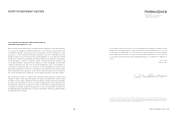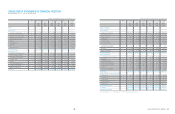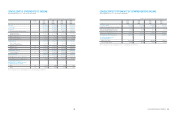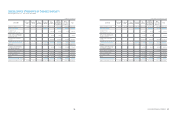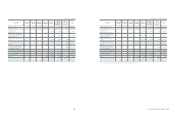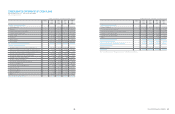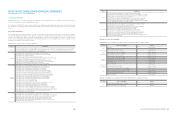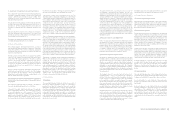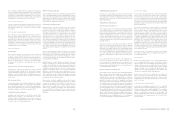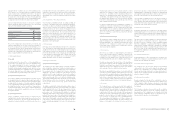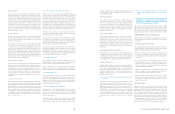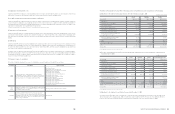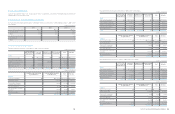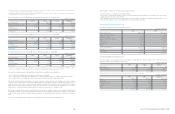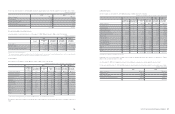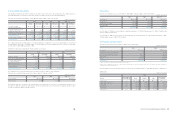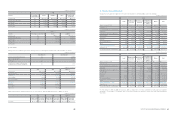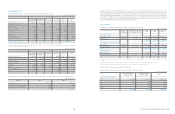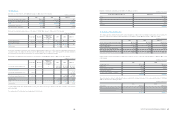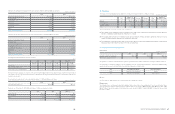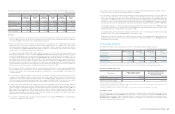Samsung 2010 Annual Report Download - page 26
Download and view the complete annual report
Please find page 26 of the 2010 Samsung annual report below. You can navigate through the pages in the report by either clicking on the pages listed below, or by using the keyword search tool below to find specific information within the annual report.48 49
NOTES TO THE CONSOLIDATED FINANCIAL STATEMENTS
1) Sales of goods
Sales of products and merchandise are recognized upon delivery
when the significant risks and rewards of ownership of goods have
transferred to the buyer, continuing managerial involvement usually
associated with ownership and effective control have ceased, the
amount of revenue can be measured reliably, it is probable that the
economic benefits associated with the transaction will flow to the
Company and the costs incurred or to be incurred in respect of
the transaction can be measured reliably. The Company records
reductions to revenue for special pricing arrangements, price
protection and other volume based discounts. If product sales are
subject to customer acceptance, revenue is not recognized until
customer acceptance occurs.
2) Sales of services
Revenues from rendering services are generally recognized using
the percentage-of-completion method, based on the percentage
of costs to date compared to the total estimated costs, contractual
milestones or performance.
The Company enters into transactions involving multiple components
consisting of any combination of goods, services, etc. The
commercial effect of each separately identifiable component of
the transaction is evaluated in order to reflect the substance of the
transaction. The consideration received from these transactions is
allocated to each separately identifiable component based on the
relative fair value of each component. The Company determines the
fair value of each component by taking into consideration factors
such as the price when component or a similar component is sold
separately by the Company or a third party.
3) Other sources of revenue
Interest income is recognized using the effective interest method.
When a loan and receivable is impaired, the Company reduces the
carrying amount to its recoverable amount, being the estimated
future cash flow discounted at the original effective interest rate of
the instrument, and continues unwinding the discount as interest
income. Royalty income is recognized on an accruals basis in
accordance with the substance of the relevant agreements.
Dividend income is recognized when the right to receive payment is
established.
2.20 Government Grants
Grants from the government are recognized at their fair value where
there is a reasonable assurance that the grant will be received and
the Company will comply with the conditions attached. Government
grants relating to income are deferred and recognized in the
statement of income over the period necessary to match them with
the income that they are intended to compensate. Government
grants relating to property, plant and equipment are included in non-
current liabilities as deferred government grants and are credited to
the statement of income on a straight-line basis over the expected
lives of the related assets.
2.21 Income Tax Expense and Deferred Taxes
Deferred income tax is recognized, using the liability method, on
temporary differences arising between the tax bases of assets and
liabilities and their carrying amounts in the consolidated financial
statements. However, the deferred income tax is not accounted
for if it arises from initial recognition of an asset or liability in a
transaction other than a business combination that at the time of
the transaction affects neither accounting nor taxable profit or loss.
Deferred income tax is determined using tax rates (and laws) that
have been enacted or substantively enacted by the balance sheet
date and are expected to apply when the related deferred income
tax asset is realized or the deferred income tax liability is settled.
Deferred income tax assets are recognized only to the extent that it
is probable that future taxable profit will be available against which
the temporary differences can be utilized.
Deferred income tax is provided on temporary differences arising
on investments in subsidiaries, associates and joint ventures
except where the timing of the reversal of the temporary difference
is controlled by the group and it is probable that the temporary
difference will not reverse in the foreseeable future.
Deferred income tax assets and liabilities are offset when there is a
legally enforceable right to offset current tax assets against current
tax liabilities and when the deferred income taxes assets and
liabilities relate to income taxes levied by the same taxation authority
on either the taxable entity or different taxable entities where there
is an intention to settle the balances on a net basis.
2.22 Earnings Per Share
Basic earnings per share is calculated by dividing net profit for the
period available to common shareholders by the weighted-average
number of common shares outstanding during the year.
Diluted earnings per share is calculated using the weighted-average
number of common shares outstanding adjusted to include the
potentially dilutive effect of common equivalent shares outstanding.
2.23 Segment Reporting
Operating segments are reported in a manner consistent with
the internal reporting provided to the chief operating decision-
maker. The chief operating decision-maker, who is responsible for
making strategic decisions on resource allocation and performance
assessment of the operating segments, has been identified as the
company’s Management Committee.
2.24 Critical Estimates and Judgments
The preparation of consolidated financial statements requires
management to exercise significant judgment and assumptions
based on historical experience and other factors, including
expectations of future events that are believed to be reasonable
under the circumstances.
The Company makes estimates and assumptions concerning the
future. The resulting accounting estimates will, by definition, seldom
equal the related actual results. The estimates and assumptions
that have a significant risk of causing a material adjustment to the
carrying amounts of assets and liabilities within the next financial
year are addressed below.
1) Revenue recognition
The Company uses the percentage-of-completion method in
accounting for its fixed-price contracts to deliver installation
services. Use of the percentage-of-completion method requires
the company to estimate the services performed to date as a
proportion of the total services to be performed. Revenues and
earnings are subject to significant change, effected by early steps
in a long-term projects, change in scope of a project, cost, period,
and plans of the customers.
2) Provision for warranty (Note 16)
The Company recognizes provision for warranty at the point of
recording related revenue. The company accrues provision for
warranty based on the best estimate of amounts necessary to
settle future and existing claims on products sold as of each
balance sheet date. Continuous release of products, that are more
technologically complex and changes in local regulations and
customs could result in additional allowances being required in
future periods.
3) Estimated impairment of goodwill (Note 12, 33)
The Company tests at the end of each reporting period whether
goodwill has suffered any impairment in accordance with the
accounting policy described in Note 2.11. The recoverable amounts
of cash generating units have been determined based on value-in-
use calculations. These calculations require the use of estimates.
4) Legal contingencies (Note 17)
Legal proceedings covering a wide range of matters are pending or
threatened in various jurisdictions against the Company. Provisions
are recorded for pending litigation when it is determined that an
unfavorable outcome is probable and the amount of loss can be
reasonably estimated. Due to the inherent uncertain nature of
litigation, the ultimate outcome or actual cost of settlement may
materially vary from estimates.
2.25 Convenience Translation into United States Dollar
Amounts
The Company operates primarily in Korean Won and its official
accounting records are maintained in Korean Won. The U.S.
dollar amounts provided in the financial statements represent
supplementary information solely for the convenience of the
reader. All Won amounts are expressed in U.S. dollars at the rate
of
₩
1,138.90 to US $1, the exchange rate in effect on December
31, 2010. Such presentation is not in accordance with generally
accepted accounting principles, and should not be construed as
a representation that the Won amounts shown could be readily
converted, realized or settled in U.S. dollars at this or at any other
rate.
2.26 These consolidated financial statements were
approved by the Board of Directors on January 28,
2011.
3. Transition to International Financial Reporting
Standards as adopted by the Republic of
Korea from Generally Accepted Accounting
Principle in the Republic of Korea.
The Company adopted Korean IFRS from the fiscal year 2010
(the date of first-time adoption to Korean IFRS: January 1, 2010).
The comparison year, 2009,is restated in accordance with Korean
IFRS 1101, First-time adoption of international financial reporting
standards (the date of transition to Korean IFRS: January 1, 2009).
Significant differences in accounting policies
Significant differences between the accounting policies chosen by
the Company under Korean IFRS and under previous Korean GAAP
are as follows:
1) First time adoption of Korean IFRS
The Company elected the following exemptions upon the adoption
of Korean IFRS in accordance with Korean IFRS 1101, First-time
adoption of international financial reporting standards:
a) Business combination: Past business combinations that
occurred before the date of transition to Korean IFRS will not
be retrospectively restated under Korean IFRS 1103, Business
combinations.
b) Fair value as deemed cost: The Company elects to measure
certain land assets at fair value at the date of transition to Korean
IFRS and use the fair value as its deemed cost. Valuations were
made on the basis of recent market transactions on the arm's
length terms by independent valuers.
c) Cumulative translation differences: All cumulative translation gains
and losses arising from foreign subsidiaries and associates as of
the date of transition to Korean IFRS are reset to zero.
d) Employee benefits: The Company elected to use the ‘corridor’
approach for actuarial gains and losses and all cumulative
actuarial gains and losses have been recognized at the date of
transition to Korean IFRS.
2) Employee benefits
Employees and directors with at least one year of service are
entitled to receive a lump-sum payment upon termination of their
employment with SEC, its Korean subsidiaries and certain foreign
subsidiaries, based on their length of service and rate of pay at the
time of termination. Under the previous severance policy pursuant
to Korean GAAP, Accrued severance benefits represented the
amount which would be payable assuming all eligible employees
and directors were to terminate their employment as of the end
of the reporting period. However, under Korean IFRS, the liability
is determined based on the present value of expected future
payments calculated and reported using actuarial assumptions.


